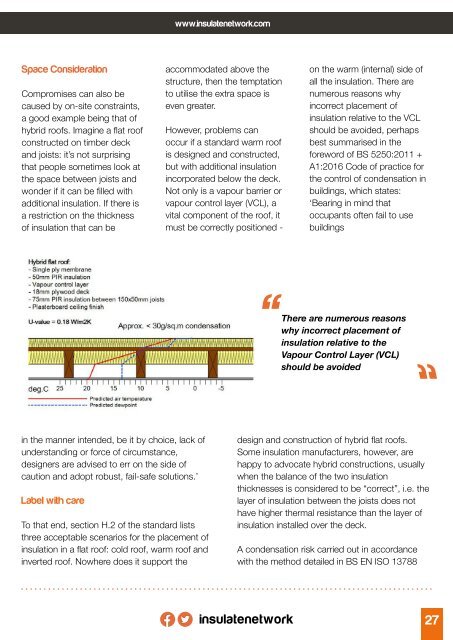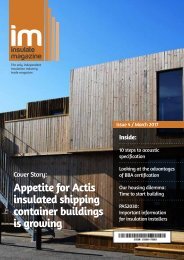Insulate Magazine Issue 11
Create successful ePaper yourself
Turn your PDF publications into a flip-book with our unique Google optimized e-Paper software.
www.insulatenetwork.com<br />
Space Consideration<br />
Compromises can also be<br />
caused by on-site constraints,<br />
a good example being that of<br />
hybrid roofs. Imagine a flat roof<br />
constructed on timber deck<br />
and joists: it’s not surprising<br />
that people sometimes look at<br />
the space between joists and<br />
wonder if it can be filled with<br />
additional insulation. If there is<br />
a restriction on the thickness<br />
of insulation that can be<br />
accommodated above the<br />
structure, then the temptation<br />
to utilise the extra space is<br />
even greater.<br />
However, problems can<br />
occur if a standard warm roof<br />
is designed and constructed,<br />
but with additional insulation<br />
incorporated below the deck.<br />
Not only is a vapour barrier or<br />
vapour control layer (VCL), a<br />
vital component of the roof, it<br />
must be correctly positioned -<br />
on the warm (internal) side of<br />
all the insulation. There are<br />
numerous reasons why<br />
incorrect placement of<br />
insulation relative to the VCL<br />
should be avoided, perhaps<br />
best summarised in the<br />
foreword of BS 5250:20<strong>11</strong> +<br />
A1:2016 Code of practice for<br />
the control of condensation in<br />
buildings, which states:<br />
‘Bearing in mind that<br />
occupants often fail to use<br />
buildings<br />
There are numerous reasons<br />
why incorrect placement of<br />
insulation relative to the<br />
Vapour Control Layer (VCL)<br />
should be avoided<br />
in the manner intended, be it by choice, lack of<br />
understanding or force of circumstance,<br />
designers are advised to err on the side of<br />
caution and adopt robust, fail-safe solutions.’<br />
Label with care<br />
To that end, section H.2 of the standard lists<br />
three acceptable scenarios for the placement of<br />
insulation in a flat roof: cold roof, warm roof and<br />
inverted roof. Nowhere does it support the<br />
design and construction of hybrid flat roofs.<br />
Some insulation manufacturers, however, are<br />
happy to advocate hybrid constructions, usually<br />
when the balance of the two insulation<br />
thicknesses is considered to be “correct”, i.e. the<br />
layer of insulation between the joists does not<br />
have higher thermal resistance than the layer of<br />
insulation installed over the deck.<br />
A condensation risk carried out in accordance<br />
with the method detailed in BS EN ISO 13788<br />
insulatenetwork<br />
27
















